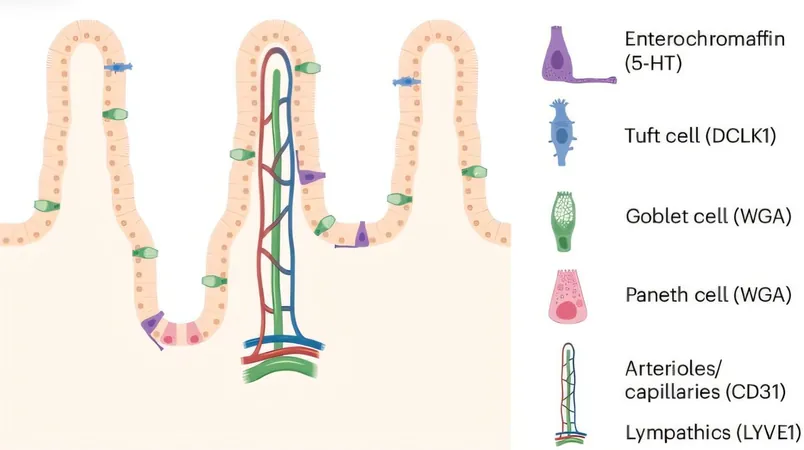
Unlocking the Secrets of the Gut's 'Brain': A Breakthrough in Gastrointestinal Health
2025-05-29
Author: Rajesh
Discovering the Gut's Hidden Neural Networks
Researchers from Karolinska Institutet have made a groundbreaking discovery about our gut’s nervous system, often referred to as the 'brain in the gut.' They have identified three types of nerve cells linked directly to intestinal villi, suggesting that there may be previously unknown neural networks at play—specifically regulating fluid balance in the gut.
A Deep Dive into Gastrointestinal Disorders
With over 30% of the Swedish population suffering from chronic gastrointestinal disorders like irritable bowel syndrome (IBS) and inflammatory bowel disease (IBD), understanding the underlying causes remains a medical mystery. The new findings presented in the journal Nature Neuroscience could shed light on these perplexing diseases.
New Insights into Neural Connectivity
The researchers focused on the submucosal nerve layer, an area often neglected in previous studies. Interestingly, they discovered not just one, but three distinct types of nerve cells within this layer, including a sensory nerve cell capable of detecting intestinal contents. These cells could play a critical role in enhancing nutrient absorption and maintaining fluid balance.
Innovative Research Techniques Used
Using cutting-edge single-cell RNA sequencing, the team has been able to map the activity of genes within the nerve cells. By employing genetically modified mice, they visualized the intricate communication between the nerve cells and intestinal epithelial cells, unlocking new perspectives on gut health.
Connecting the Dots: Neural Networks
These findings reveal that all three identified nerve cell types are interlinked, as well as connected to the intestinal villi. This discovery opens the door to the possibility of unknown neural networks regulating crucial functions like fluid balance and blood flow—functions that are essential in managing conditions such as constipation and diarrhea.
Developmental Insights: A Stepwise Maturation Process
The study also showcases how these nerve cell types develop through a meticulous maturation process during fetal development, mirroring the maturation seen in the outer myenteric layer of the gut. This contrasts with the development of nerve cells in the brain, suggesting a unique evolutionary pathway for the enteric nervous system.
Implications for Future Treatments and Regenerative Medicine
Armed with this knowledge, there's potential for revolutionary treatments targeting specific nerve cells with new medications. Additionally, these insights could be invaluable for regenerative medicine, particularly in creating nerve cell types for conditions like Hirschsprung's disease using stem cells.
What’s Next for Researchers?
The research team intends to delve further into how these three types of nerve cells react to various stimuli, such as pressure from intestinal contents, and the specific molecules they employ for communication. The ultimate aim is to deepen our understanding of how the gut manages essential functions like fluid balance and blood flow—key factors in addressing both diarrhea and constipation.




 Brasil (PT)
Brasil (PT)
 Canada (EN)
Canada (EN)
 Chile (ES)
Chile (ES)
 Česko (CS)
Česko (CS)
 대한민국 (KO)
대한민국 (KO)
 España (ES)
España (ES)
 France (FR)
France (FR)
 Hong Kong (EN)
Hong Kong (EN)
 Italia (IT)
Italia (IT)
 日本 (JA)
日本 (JA)
 Magyarország (HU)
Magyarország (HU)
 Norge (NO)
Norge (NO)
 Polska (PL)
Polska (PL)
 Schweiz (DE)
Schweiz (DE)
 Singapore (EN)
Singapore (EN)
 Sverige (SV)
Sverige (SV)
 Suomi (FI)
Suomi (FI)
 Türkiye (TR)
Türkiye (TR)
 الإمارات العربية المتحدة (AR)
الإمارات العربية المتحدة (AR)